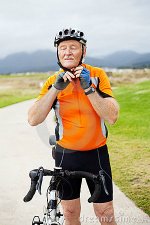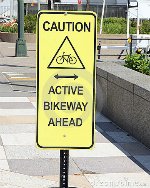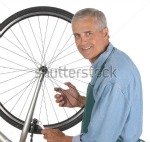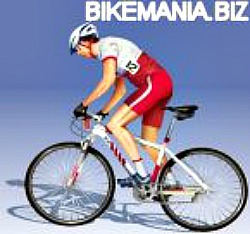Bicycling Tips.
A Primer For New Or
Returning Boomer Cyclists
Many boomers haven't been on a bike since grade school and there are lots of bicycling tips here that can help you get back in the saddle again hassle free. You never forget how to ride a bike but there is a whole lot more about cycling that we want to consider as a boomer then as a kid.
Take a few minutes and review these tips. I have done the trial and error and it’s definitely not the way to go. There is a lot of information here that you are not likely to find elsewhere, from a boomers perspective, that can save you time, money, and frustration and keep you riding happily for years to come.
Cycling fitness
- One of the most important cycling tips I can give you is to consult your doctor to make sure you have no health issues that would stop you from riding. He, or she, will probably jump for joy because you will be getting some great exercise. But, you should discuss it with them anyway.
 |
|
- One of the best cycling tips I can give you is to take it easy on your first few rides until you build up your strength and endurance. Try to be a little patient.
- Don't get too concerned if you get a sore butt on the first several rides. This is normal and it will toughen up. Good bike shorts and some chamois butter will help this a lot. You may opt for a different saddle later but give it a little time.
- A great cycling tip for the sore butt syndrome is to use a lubricant like Friction Zone or Chamois Butter and do not wear underwear under your bike shorts. It took me quite a while to accept this fact but it makes a huge difference. Underwear beneath your bike shorts just causes friction and friction is the last thing that you want.
- Stay hydrated. You will need at least one bottle of water and preferably two for longer rides. Also, there are hydrating systems available for long rides. Try an energy drink and keep an energy bar or two with you. Try eating it at about the halfway point of your ride. They really do help.
Getting Started
- Talk to as many bike riders as possible and get some bicycling tips from them. Especially, about where they ride and what they do, or don't, like about the bike that they are riding. You can get some good tips "right from the horse's mouth".
- You need to determine where you will do most of your riding. Will it be on a road, bike path, trail, etc. This is one of the most important aspects to consider when choosing a bicycle is that it is right for your taste, your body style, and your budget.
- Buy the best bicycle that fits your needs, your body, and your budget. Most department store bikes are heavy, prone to rust, and hard to maintain.
- Remember to budget some for accessories and equipment.
- You are going to want some type of bag. I use a handlebar bag that is a little bigger than some people like but, I keep a light windbreaker in it as well as my tools, a spare tube, and a few energy bars and a tire pressure gauge. Again, talk to other bike riders and get some tips from them.
- You will need some basic bicycle tools. You don't need a whole tool-box full. There are some clever combination tools that will do fine for most riders.
 |
|
- Also, I suggest that you carry a little key case with a house and car key in it, a few band aids, as well as a, just in case, $20 or so. I keep this in my bag.
- Learn the rules of the road for cyclists and take them to heart. They exist for your safety.
- Make sure that you have the right kind of tires for the surface that you are riding on. Smooth tires and loose gravel can cause a nasty fall.
- If you carry a cell phone with you keep it in your pocket or bag and do not use it when you are riding. If you are going to be doing long road trips you may want to consider a cell phone with a GPS.
- Do not take a road bike, with smooth skinny tires, on a bike path unless it is paved and smooth. It doesn't work and you could hurt yourself or your bike.
- If you ride in the evening make sure that you aren't too far away from your starting point to get back well before dark. If you have to ride at night make sure you have a good light and several good reflectors.
- Another handy cycling tip for you is to always check your tire pressure before you leave home. I use a small electric powered air compressor if I do need air which sure beats a pump. And, they are cheap. After you ride for a few years you can tell by feel if you need to inflate your tires more.
- Keep a spare tube in your bag along with a small container of baby powder. This will help the tube to seat in the tire, if you do have to change it, and make the job a lot easier.
Keep your bike secure
- Get a good bicycle lock. Also,if you are going to transport your bike get a cable lock, and be aware that any small accessories, like frame mounted bicycle pumps, or even bags, may not be there when you come back.
- I use a removable bag with a strap that I can take with me. At the very least take this stuff off and put it in your car if you are carrying your bike on a rack.
- If you are transporting your bike on a rack use a few extra bungee cords to be on the safe side. It may take a little longer to mount or dismount it but at least you won't leave it along the highway. If you opt for a roof rack get the lockable mounts and roof mount adapters.
Basic maintenance and repair
 |
|
- You will need to clean your bike occasionally depending on how frequently you ride and there are a few tips that you should keep in mind like...
- Use an environmentally safe cleaner or just warm soapy water.
- Use brushes to clean out hard to reach places where dirt accumulates.
- Spray de-greaser on the chain from the top down and
- Do not use a high pressure hose since you risk washing the lubricant out of bearings and hinge points that need to be lubricated.
- let it soak for a few minutes before cleaning with a brush and soft rag.
- Dry with a clean, soft rag to prevent scratching.
- Make sure to lubricate critical points after you clean like the chain and sprockets as well as any hinge points like derailleurs, brake pivots. A good lubricant is called Tri Flow which has teflon particles as well as excellent penetration and lubrication characteristics.
More usefull tips
- Plan your rides so you don't find yourself too pooped to get back home, or back to your car, if you are transporting your bike to the bike path.
- If you are planning to ride on a long straight bike path (a lot of them were once railroad tracks) check the wind before you go. You probably don't want to be riding into a stiff headwind on the return trip.
- If possible, on a windy day, plan a circular route that will bring you back to your starting point.
- If you are planning a longer road trip do it by car first and try to visualize being on a bike as you go.
- Here is a cycling tip I've never seen anywhere else. Consider a seat post mounted rear fender. They are available in a very light polycarbonate (plastic) and weigh almost nothing. If you don't have one, and ride through a puddle, you will get a wet muddy back on your jersey. Women, especially, aren't thrilled to have a wet muddy back.
- You may want to use bar ends that mount on the ends of your handlebar at right angles. I have them slanted towards the front of the bike. Sometimes it just feels good to change your hand position. Don't use them in traffic though since your hands should be close to the brakes.Also, they enable you to stand occasionally as you ride, give your butt a break, and still have good control of your bike.
- Bicycle shoes make a big difference when riding but not well suited for walking. They are uncomfortable to walk in and you can harm the cleats in the shoes walking on a hard surface. If you need to do a lot of walking keep walking shoes or sneakers in your bag.
- Do not over-lube your chain. You are killing it with kindness. Lube it only if it appears shiny but do not wait until it squeaks. Too much lubricant attracts more dirt and makes your chain wear out faster. When you do lube it make sure you wipe off the excess.
- Consider doing your errands on a bike. When you think about how many times you run out to a convenience store, post office, etc, you could have some fun and get some good exercise, while you are at it and, without a lot of planning. There are all kinds of bags and baskets that snap on and off so you can even take them in the store with you.
Return from bicycling tips to home page


